Trackers direct solar panels or modules toward the sun. These devices change their orientation throughout the day to follow the sun’s path to maximize energy capture.
In photovoltaic systems, trackers help minimize the angle of incidence (the angle that a ray of light makes with a line perpendicular to the surface) between the incoming light and the panel, which increases the amount of energy the installation produces.

Fundamentally, there are two types of trackers available:
Single axis solar trackers: They rotate on one axis moving back and forth in a single direction. Different types include horizontal, vertical, tilted, and polar aligned.
Dual axis solar trackers: They continually face the sun because they can move in two different directions. It is typically used to orient a mirror and redirect sunlight along a fixed axis towards a stationary receiver. Because these trackers follow the sun vertically and horizontally they help obtain maximum solar energy generation.
Working Principle of Solar Trackers
There are two different drivers that dictate the motion of the trackers: passive and active.
Passive trackers depend solely on solar heat to guide and move the tracker. Basically, a low boiling point compressed gas fluid is driven to one side or the other to move the tracker like a teeter totter in response to the imbalance created by the heat from the sun.
Active trackers use a controller that monitors the position of the sun’s movement in order to direct motors that move the trackers.
In most active solar trackers, Light Dependent Resistors (LDRs) are used as sensor. Their difference in output is used to generate error signals. In these systems, for instance, when the outputs of eastern and western LDRs become equal, the east to west tracking ends. A computer or a processor calculates the sun’s position from formulae or algorithms using its time/date and geographical information to send signals to the motor orient the apparatus in such direction where illumination of sensors becomes equal and balanced.
In some high end solar trackers, a feedback system is employed wherein the output signal of various processes is sent back as the input to the system that it is controlling. Consequently, it can correct any errors and compensate for disturbances in the system.






